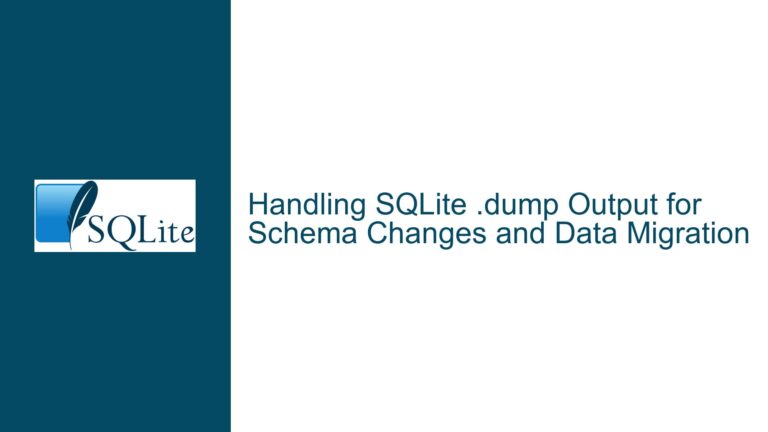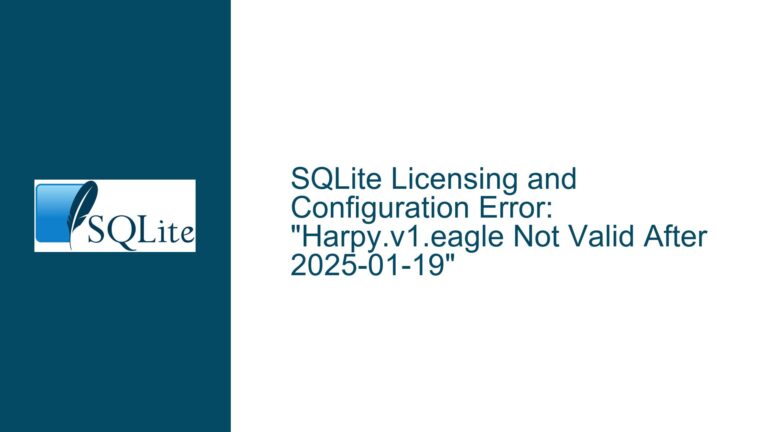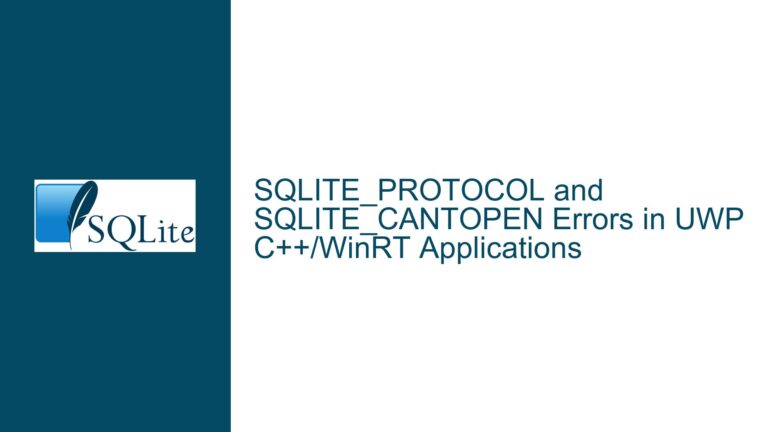Implementing DML RETURNING Clause in SQLite for Enhanced Query Efficiency
SQLite’s Lack of DML RETURNING Clause and Its Implications
SQLite, a widely-used lightweight database engine, currently lacks support for the Data Manipulation Language (DML) RETURNING clause, a feature available in other database systems like PostgreSQL, MariaDB, Oracle, and SQL Server. The DML RETURNING clause allows users to retrieve the results of an INSERT, UPDATE, or DELETE operation directly within the same query, thereby reducing verbosity and potentially improving performance by combining query execution and result retrieval into a single operation.
The absence of the RETURNING clause in SQLite has several implications. First, it increases the verbosity of queries, particularly in interactive environments like REPLs (Read-Eval-Print Loops), where users often need to execute multiple queries to achieve the same result. For example, after inserting a row, a user must execute a separate SELECT query to retrieve the inserted data. This not only complicates the code but also introduces additional overhead, as the database engine must process multiple queries instead of a single, optimized one.
Second, the lack of a RETURNING clause complicates scenarios involving the ON CONFLICT clause in INSERT statements. When inserting multiple rows, some rows may be ignored or updated due to conflicts, making it difficult to determine which rows were actually inserted. Currently, SQLite provides the last_insert_rowid() function to retrieve the rowid of the last inserted row, but this function is not thread-safe and does not provide information about multiple rows or rows affected by ON CONFLICT clauses.
Finally, the absence of the RETURNING clause limits SQLite’s compatibility with other database systems that support this feature. Developers working with multiple databases must write additional code to handle the differences, increasing the complexity of cross-database applications.
Challenges in Implementing the RETURNING Clause in SQLite
Implementing the DML RETURNING clause in SQLite presents several technical challenges. One of the primary challenges is ensuring thread safety. The last_insert_rowid() function, which is currently used to retrieve the rowid of the last inserted row, is not thread-safe. This means that in a multi-threaded environment, concurrent INSERT operations could lead to race conditions, where the rowid returned by last_insert_rowid() does not correspond to the row inserted by the current thread. Implementing a RETURNING clause would require addressing these thread-safety issues, potentially by introducing new mechanisms to track inserted rows in a thread-safe manner.
Another challenge is handling the ON CONFLICT clause in INSERT statements. When an INSERT statement includes an ON CONFLICT clause, some rows may be ignored or updated instead of being inserted. In such cases, the RETURNING clause must accurately reflect which rows were inserted, which were ignored, and which were updated. This requires careful tracking of the changes made by the INSERT statement, which could introduce additional complexity and overhead.
Additionally, implementing the RETURNING clause would require modifications to SQLite’s query execution engine. Currently, SQLite processes DML statements and SELECT statements separately. To support the RETURNING clause, the engine would need to be modified to combine these operations, allowing the results of a DML operation to be returned directly within the same query. This could involve significant changes to the query planner and executor, potentially impacting the performance and stability of the database engine.
Finally, there is the challenge of maintaining backward compatibility. SQLite is widely used in a variety of applications, and any changes to the database engine must ensure that existing applications continue to function correctly. This means that the implementation of the RETURNING clause must be carefully designed to avoid breaking changes, while still providing the desired functionality.
Strategies for Implementing and Optimizing the RETURNING Clause in SQLite
To address the challenges associated with implementing the DML RETURNING clause in SQLite, several strategies can be employed. First, to ensure thread safety, SQLite could introduce a new mechanism for tracking inserted rows that is designed to work in multi-threaded environments. This could involve the use of thread-local storage or other synchronization mechanisms to ensure that each thread can safely retrieve the rows it has inserted without interference from other threads.
Second, to handle the ON CONFLICT clause, SQLite could extend the RETURNING clause to include additional information about the outcome of each row. For example, the RETURNING clause could return a status indicator for each row, indicating whether it was inserted, ignored, or updated. This would allow developers to accurately determine the outcome of each row in an INSERT statement, even when conflicts occur.
Third, to modify the query execution engine, SQLite could introduce a new query planning and execution strategy specifically for DML statements with a RETURNING clause. This strategy would combine the execution of the DML operation with the retrieval of the results, allowing the database engine to optimize the query as a single operation. This could involve changes to the query planner to recognize RETURNING clauses and generate efficient execution plans, as well as changes to the executor to handle the combined operation.
Finally, to maintain backward compatibility, SQLite could introduce the RETURNING clause as an optional feature that is disabled by default. This would allow existing applications to continue functioning without modification, while enabling new applications to take advantage of the RETURNING clause by explicitly enabling it. Over time, as the feature becomes more widely adopted and tested, it could be enabled by default in future versions of SQLite.
In addition to these strategies, several optimizations could be implemented to improve the performance of the RETURNING clause. For example, SQLite could optimize the storage and retrieval of the returned rows by using efficient data structures and algorithms. The database engine could also take advantage of indexing and other query optimization techniques to minimize the overhead of the RETURNING clause.
To further enhance compatibility with other database systems, SQLite could adopt a syntax for the RETURNING clause that is similar to that used by PostgreSQL and other databases. This would make it easier for developers to write cross-database applications and reduce the learning curve for those already familiar with the RETURNING clause in other systems.
In conclusion, while implementing the DML RETURNING clause in SQLite presents several challenges, these challenges can be addressed through careful design and optimization. By introducing new mechanisms for thread safety, extending the RETURNING clause to handle the ON CONFLICT clause, modifying the query execution engine, and maintaining backward compatibility, SQLite can provide a powerful new feature that enhances query efficiency and reduces verbosity. With these strategies in place, SQLite can continue to evolve as a versatile and efficient database engine, meeting the needs of developers and applications in a wide range of environments.






